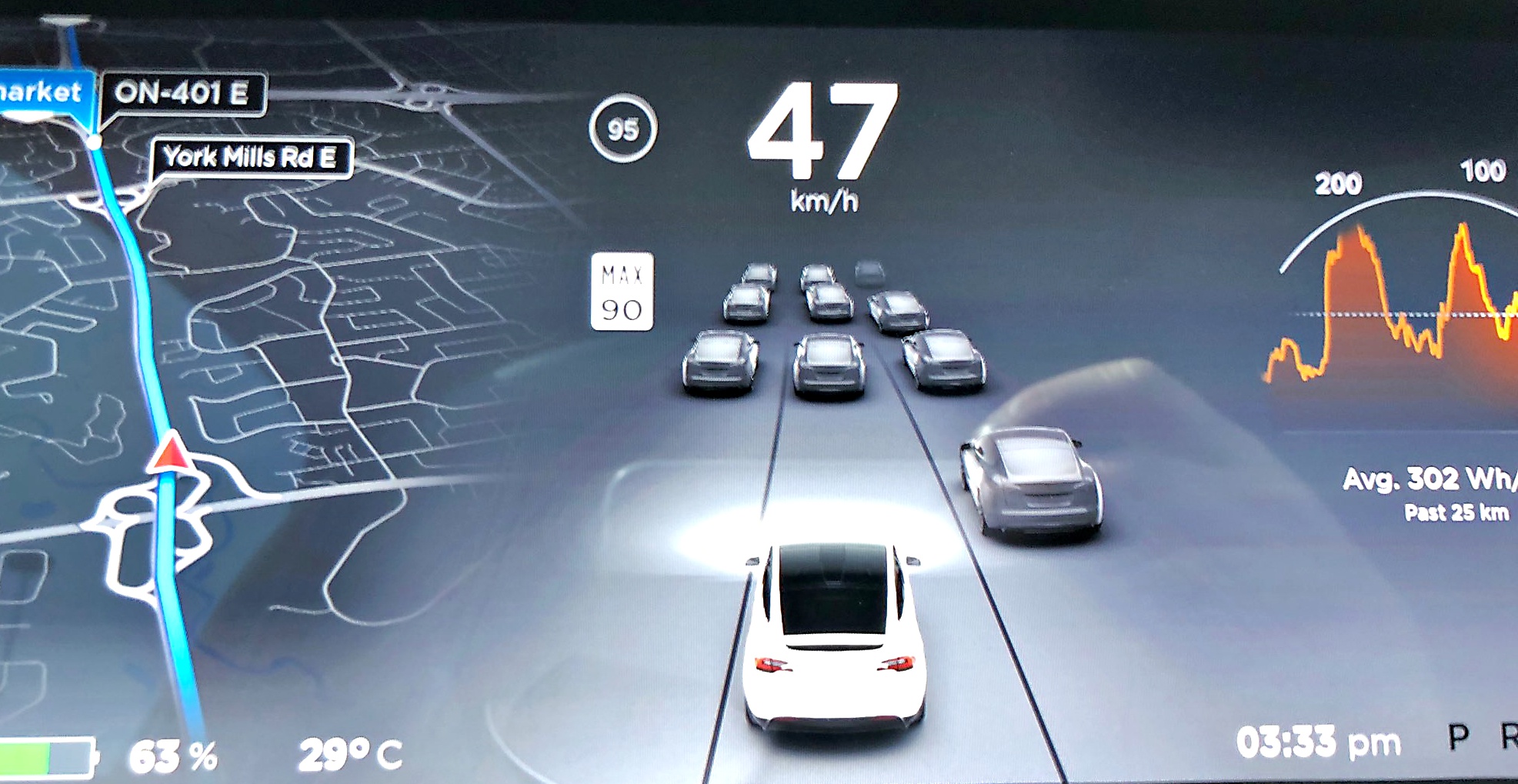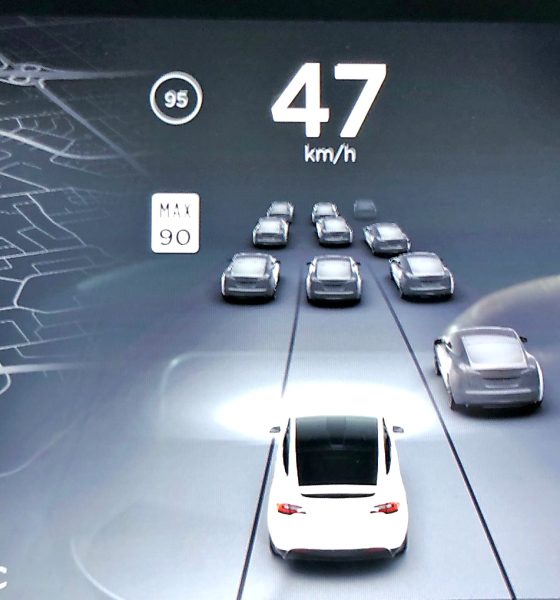

News
Tesla (Enhanced) Autopilot vs. Full Self-Driving: What’s the difference now?
Tesla has announced a 50% price reduction on Autopilot and Full Self-Driving Capability for existing Model S, Model X and Model 3 vehicles.
Interested buyers of Tesla’s semi-autonomous feature package can use a new one-click payment process to add Autopilot to an existing vehicle for $2,000 (originally $4,000 when purchased after vehicle delivery) and Full Self-Driving for $2,000, reduced from the original price of $5,000 when added after delivery. The announcement comes a day after Tesla launched its $35,000 Model 3, and drastically reduced the price of its flagship Model S and Model X vehicles.
Tesla explains in a new blog post, “All customers who bought a Tesla before yesterday’s price decrease will be able to buy the Autopilot or Full Self-Driving capability for half of what those features would normally cost after initial purchase.”
Though the announcement is a seemingly welcomed change, the Autopilot update has created some confusion among Tesla owners, prompting CEO Elon Musk to clarify over Twitter.
If you bought enhanced autopilot, FSD upgrade costs $2k instead of $5k
— Elon Musk (@elonmusk) March 2, 2019
Tesla Autopilot
On February 28, 2019, Tesla updated the details for its Autopilot suite that includes the replacement of “Enhanced Autopilot” with “Autopilot”, along with adjustments to pricing and features.
Taking a closer look at the details between Tesla’s original Enhanced Autopilot and what’s now being called Autopilot, and it’s evident that Tesla shifted some of the original features of Enhanced Autopilot to Full Self-Driving. However, Tesla also added two additional features to the Full Self-Driving Capability that will enable the vehicle to recognize and respond to traffic lights and stop signs, and perform automatic driving on city streets.
Autopilot Cost
The cost of Autopilot depends on several factors depending on the date a Model S, Model X or Model 3 was purchased and also if Autopilot was added at the time of vehicle purchase.
- Autopilot – $2,000 (this is the newly introduced 50% discount) when added to a vehicle that was purchased without Enhanced Autopilot. Vehicle must be purchased before February 28, 2019.
- Autopilot – $3,000 when added at the time of vehicle purchase. Vehicle must be purchased on February 28, 2019, or anytime thereafter.
- Autopilot – $4,000 when added to a vehicle after delivery. Vehicle must be purchased on February 28, 2019, or anytime thereafter.
Autopilot Features*
Auto Lane Change- Autosteer
- Traffic-Aware Cruise Control
AutoparkSummonNavigate on Autopilot
* The strikethroughs represents features that were originally part of Enhanced Autopilot but now moved to Full Self-Driving Capability.
Tesla Full Self-Driving (FSD) Capability, updated February 28, 2019
Autopilot Full Self-Driving Cost
The cost for Tesla’s Full Self-Driving feature also varies depending on the date of vehicle purchase. FSD requires Autopilot.
- FSD – $2,000 (this is the newly introduced 50% discount) when added to any Model S, Model X, or Model 3 that was purchased with Enhanced Autopilot before February 28, 2019. Total cost of EAP ($5,000) + FSD ($2,000) = $7,000.
- FSD – $3,000 when added to any Model S, Model X, or Model 3 that was purchased without Enhanced Autopilot before February 28, 2019. Total cost of AP ($2,000) + FSD ($3,000) = $5,000.
- FSD – $5,000 when added at the time of vehicle purchase on February 28, 2019, or anytime thereafter. Total cost of AP ($3,000) + FSD ($5,000) = $8,000.
- FSD – $7,000 when added to a vehicle that was purchased on February 28, 2019, or anytime thereafter, and already delivered. Total cost of AP ($4,000) + FSD ($7,000) = $11,000.
FSD Features*
- Autopark: both parallel and perpendicular spaces.
- Navigate on Autopilot: automatic driving from highway on-ramp to off-ramp including interchanges and overtaking slower cars.
- (Advanced) Summon: “Your parked car will come find you anywhere in a parking lot. Really.”
- Coming later in 2019: Recognize and respond to traffic lights and stop signs.
- Coming later in 2019: Automatic driving on city streets.
Tesla’s online configurator, March 2019
Tesla explains the recent Autopilot update in its blog post, which we’ve provided below.
Upgrading to Autopilot and Full Self-Driving Capability
All customers who bought a Tesla before yesterday’s price decrease will be able to buy the Autopilot or Full Self-Driving capability for half of what those features would normally cost after initial purchase.
Autopilot, which enables automatic steering, accelerating and braking, normally costs $4,000 after delivery and Full Self-Driving normally costs $7,000 after delivery. Full Self-Driving capability includes Navigate on Autopilot, Advanced Summon, Auto Lane Change, Autopark and, later this year, will recognize and respond to traffic lights.
Any customer who bought a Tesla prior to this week’s price adjustment will be able to upgrade to Autopilot for $2,000 or Full Self-Driving capability for an additional $3,000. In other words, for a customer who previously hadn’t purchased Autopilot plus Full Self-Driving, they will soon be able to do so for $6,000 less than before. Customers who previously purchased Full Self-Driving will receive an invitation to Tesla’s Early Access Program (EAP). EAP members are invited to experience and provide feedback on new features and functionality before they are rolled out to other customers.
Beginning next month, any existing customer who wants to upgrade to Autopilot or Full Self-Driving capability will be able to do so with a one-click payment. There will be no need to call anyone, and it will be as easy as it was to order your car in the first place.

News
Tesla FSD fleet is nearing 7 billion total miles, including 2.5 billion city miles
As can be seen on Tesla’s official FSD webpage, vehicles equipped with the system have now navigated over 6.99 billion miles.

Tesla’s Full Self-Driving (Supervised) fleet is closing in on almost 7 billion total miles driven, as per data posted by the company on its official FSD webpage.
These figures hint at the massive scale of data fueling Tesla’s rapid FSD improvements, which have been quite notable as of late.
FSD mileage milestones
As can be seen on Tesla’s official FSD webpage, vehicles equipped with the system have now navigated over 6.99 billion miles. Tesla owner and avid FSD tester Whole Mars Catalog also shared a screenshot indicating that from the nearly 7 billion miles traveled by the FSD fleet, more than 2.5 billion miles were driven inside cities.
City miles are particularly valuable for complex urban scenarios like unprotected turns, pedestrian interactions, and traffic lights. This is also the difference-maker for FSD, as only complex solutions, such as Waymo’s self-driving taxis, operate similarly on inner-city streets. And even then, incidents such as the San Francisco blackouts have proven challenging for sensor-rich vehicles like Waymos.
Tesla’s data edge
Tesla has a number of advantages in the autonomous vehicle sector, one of which is the size of its fleet and the number of vehicles training FSD on real-world roads. Tesla’s nearly 7 billion FSD miles then allow the company to roll out updates that make its vehicles behave like they are being driven by experienced drivers, even if they are operating on their own.
So notable are Tesla’s improvements to FSD that NVIDIA Director of Robotics Jim Fan, after experiencing FSD v14, noted that the system is the first AI that passes what he described as a “Physical Turing Test.”
“Despite knowing exactly how robot learning works, I still find it magical watching the steering wheel turn by itself. First it feels surreal, next it becomes routine. Then, like the smartphone, taking it away actively hurts. This is how humanity gets rewired and glued to god-like technologies,” Fan wrote in a post on X.
News
Tesla starts showing how FSD will change lives in Europe
Local officials tested the system on narrow country roads and were impressed by FSD’s smooth, human-like driving, with some calling the service a game-changer for everyday life in areas that are far from urban centers.

Tesla has launched Europe’s first public shuttle service using Full Self-Driving (Supervised) in the rural Eifelkreis Bitburg-Prüm region of Germany, demonstrating how the technology can restore independence and mobility for people who struggle with limited transport options.
Local officials tested the system on narrow country roads and were impressed by FSD’s smooth, human-like driving, with some calling the service a game-changer for everyday life in areas that are far from urban centers.
Officials see real impact on rural residents
Arzfeld Mayor Johannes Kuhl and District Administrator Andreas Kruppert personally tested the Tesla shuttle service. This allowed them to see just how well FSD navigated winding lanes and rural roads confidently. Kruppert said, “Autonomous driving sounds like science fiction to many, but we simply see here that it works totally well in rural regions too.” Kuhl, for his part, also noted that FSD “feels like a very experienced driver.”
The pilot complements the area’s “Citizen Bus” program, which provides on-demand rides for elderly residents who can no longer drive themselves. Tesla Europe shared a video of a demonstration of the service, highlighting how FSD gives people their freedom back, even in places where public transport is not as prevalent.
What the Ministry for Economic Affairs and Transport says
Rhineland-Palatinate’s Minister Daniela Schmitt supported the project, praising the collaboration that made this “first of its kind in Europe” possible. As per the ministry, the rural rollout for the service shows FSD’s potential beyond major cities, and it delivers tangible benefits like grocery runs, doctor visits, and social connections for isolated residents.
“Reliable and flexible mobility is especially vital in rural areas. With the launch of a shuttle service using self-driving vehicles (FSD supervised) by Tesla in the Eifelkreis Bitburg-Prüm, an innovative pilot project is now getting underway that complements local community bus services. It is the first project of its kind in Europe.
“The result is a real gain for rural mobility: greater accessibility, more flexibility and tangible benefits for everyday life. A strong signal for innovation, cooperation and future-oriented mobility beyond urban centers,” the ministry wrote in a LinkedIn post.
News
Tesla China quietly posts Robotaxi-related job listing
Tesla China is currently seeking a Low Voltage Electrical Engineer to work on circuit board design for the company’s autonomous vehicles.

Tesla has posted a new job listing in Shanghai explicitly tied to its Robotaxi program, fueling speculation that the company is preparing to launch its dedicated autonomous ride-hailing service in China.
As noted in the listing, Tesla China is currently seeking a Low Voltage Electrical Engineer to work on circuit board design for the company’s autonomous vehicles.
Robotaxi-specific role
The listing, which was shared on social media platform X by industry watcher @tslaming, suggested that Tesla China is looking to fill the role urgently. The job listing itself specifically mentions that the person hired for the role will be working on the Low Voltage Hardware team, which would design the circuit boards that would serve as the nervous system of the Robotaxi.
Key tasks for the role, as indicated in the job listing, include collaboration with PCB layout, firmware, mechanical, program management, and validation teams, among other responsibilities. The role is based in Shanghai.
China Robotaxi launch
China represents a massive potential market for robotaxis, with its dense urban centers and supportive policies in select cities. Tesla has limited permission to roll out FSD in the country, though despite this, its vehicles have been hailed as among the best in the market when it comes to autonomous features. So far, at least, it appears that China supports Tesla’s FSD and Robotaxi rollout.
This was hinted at in November, when Tesla brought the Cybercab to the 8th China International Import Expo (CIIE) in Shanghai, marking the first time that the autonomous two-seater was brought to the Asia-Pacific region. The vehicle, despite not having a release date in China, received a significant amount of interest among the event’s attendees.








